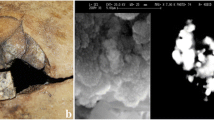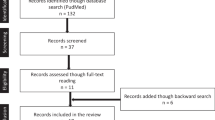Abstract
Gunshot residue (GSR) evidence may be altered or obscured by after-death events such as putrefaction, autolysis, and/or damage by animals. The present study aimed at evaluating and comparing the amount and differential distribution of GSR utilizing microcomputed tomography (microCT) analysis of fresh and decomposed gunshot wounds. A total of 60 experimental shootings at three different firing distances (5, 15, and 30 cm) were performed on human calves surgically amputated for medical reasons. Thirty specimens (10 for each tested distance) were immediately formalin-fixed, while the other 30 specimens were enclosed in a cowshed for 15 days, before formalin fixation (air temperature ranging from 11°C to 38°C). MicroCT analysis with three-dimensional image reconstruction detected GSR particles in all the investigated entrance wounds. In fresh specimens, GSR was concentrated on the skin surface around the entrance hole and in the epidermis and dermis layers around the cavity, while in decomposed specimens, the high density particles were detected only in the dermis layer. No GSR was detected in exit wounds of both fresh and decomposed specimens regardless of the tested firing distance. Statistical analysis demonstrated that also in decomposed wounds the amount of GSR roughly correlated with the distance from which the gun was fired, exhibiting, however, a higher variability than in fresh samples. The obtained results suggest that microCT analysis can be a valid screening tool for differentiating decomposed entrance and exit gunshot wounds.



Similar content being viewed by others
References
Matty W (1987) Primer composition and gunshot residue. Assoc Firearms Tool Mark Exam J 19:8–13
Wallace JS (2008) Chemical analysis of firearms, ammunition, and gunshot residue. CRC Press, Boca Raton, London, New York, Washington D.C.
Di Maio VJM (1999) Gunshot wounds. Practical aspects of firearms, ballistics, and forensic techniques. CRC Press, Boca Raton, London, New York, Washington D.C.
Groβe Perdekamp M, Nadjem H, Merkel J, Braunwarth R, Pollak S, Thierauf A (2011) Two-gun suicide by simultaneous shots to the head: interdisciplinary reconstruction on the basis of scene investigation, autopsy findings, GSR analysis and examination of firearms, bullets and cartridge cases. Int J Legal Med 125:479–485
Pollak S, Rothschild MA (2004) Gunshot injuries as a topic of medicolegal research in the German-speaking countries from the beginning of the 20th century up to the present time. Forensic Sci Int 144:201–210
Karger B, Billeb E, Koops E, Brinkmann B (2002) Autopsy features relevant for discrimination between suicidal and homicidal gunshot injuries. Int J Legal Med 116:273–278
Große Perdekamp M, Vennemann B, Mattern D, Serr A, Pollak S (2005) Tissue defect at the gunshot entrance wound: what happens to the skin? Int J Legal Med 119:217–222
Rainio J, Lalu K, Ranta H, Penttila A (2003) Morphology of experimental assault rifle skin wounds. Int J Legal Med 117:19–26
Dalby O, Butler D, Birkett JW (2010) Analysis of gunshot residue and associated materials—a review. J Forensic Sci 55:924–43
Brown H, Cauchi DM, Holden JL, Wrobel H, Cordner S (1999) Image analysis of gunshot residue on entry wounds. I—the technique and preliminary study. Forensic Sci Int 100:163–177
Stein KM, Bahner ML, Merkel J, Ain S (2000) Detection of gunshot residues in routine CTs. Int J Legal Med 114:15–18
Marty W, Sigrist T, Wyler D (2002) Determination of firing distance using the rhodizonate staining technique. Int J Legal Med 116:1–4
Cnudde V, Masschaele B, De Cock H, Olstad VL, Jacobs P (2008) Virtual histology by means high resolution X-ray CT. J Microsc 232:476–485
Cecchetto G, Giraudo C, Amagliani A, Viel G, Fais P, Cavarzeran F, Feltrin G, Ferrara SD, Montisci M (2011) Estimation of the firing distance through micro-CT analysis of gunshot wounds. Int J Legal Med 125:245–51
MacAulay LE, Barr DG, Strongman DB (2009) Effects of decomposition on gunshot wound characteristics: under moderate temperatures with insect activity. J Forensic Sci 54:443–447
Gibelli D, Brandone A, Andreola S, Porta D, Giudici E, Grandi MA, Cattaneo C (2010) Macroscopic, microscopic, and chemical assessment of gunshot lesions on decomposed pig skin. J Forensic Sci 55:1092–1097
LaGoo L, Schaeffer LS, Szymanski DW, Waddell Smith R (2010) Detection of gunshot residue in blowfly larvae and decomposing porcine tissue using inductively coupled plasma mass spectrometry (ICP-MS). J Forensic Sci 55:624–632
Udey RN, Hunter BC, Smith RW (2011) Differentiation of bullet type based on the analysis of gunshot residue using inductively coupled plasma mass spectrometry. J Forensic Sci 56:1268–1276
Pollak S, Reiter C (1988) Maggot-induced postmortem changes simulating gunshot wounds. Arch Kriminol 181:146–154
Groβe Perdekamp M, Arnold M, Merkel J, Mierdel K, Braunwarth R, Kneubuehl BP, Pollak S, Thierauf A (2011) GSR deposition along the bullet path in contact shots to composite models. Int J Legal Med 125:67–73
Brown H, Cauchi DM, Holden JL, Allen FC, Cordner S, Thatcher P (1999) Image analysis of gunshot residue on entry wounds. II—a statistical estimation of firing range. Forensic Sci Int 100:179–186
Santos A, Magalhães T, Vieira DN, Almeida AA, Sousa AV (2007) Firing distance estimation through the analysis of the gunshot residue deposit pattern around the bullet entrance hole by inductively coupled plasma-mass spectrometry: an experimental study. Am J Forensic Med Pathol 28(1):24–30
Sellier K (1991) Shot range determination. Forensic Science Progress vol. 6. Springer, Berlin
Janssen W (1984) Forensic histopathology. Springer, Berlin, Heidelberg, New York, Tokyo
Spitz WU, Fisher RS (1973) Medico-legal investigation of death. Charles C, Thomas, Springfiel
Viel G, Cecchetto G, Fabbri LD, Furlan C, Ferrara SD, Montisci M (2009) Forensic application of ESEM and XRF-EDS techniques to a fatal case of sodium phosphate enema intoxication. Int J Legal Med 123:345–350
Brozek-Mucha Z, Jankowicz A (2001) Evaluation of the possibility of differentiation between various types of ammunition by means of GSR examination with SEM–EDX method. Forensic Sci Int 123:39–47
Acknowledgements
The authors are grateful to Mr. Ennio Orpini of the Ballistic Laboratory of the “Historical Orpini's Armoury” for his help in conducting the shooting trials.
Author information
Authors and Affiliations
Corresponding author
Rights and permissions
About this article
Cite this article
Cecchetto, G., Amagliani, A., Giraudo, C. et al. MicroCT detection of gunshot residue in fresh and decomposed firearm wounds. Int J Legal Med 126, 377–383 (2012). https://doi.org/10.1007/s00414-011-0648-4
Received:
Accepted:
Published:
Issue Date:
DOI: https://doi.org/10.1007/s00414-011-0648-4




